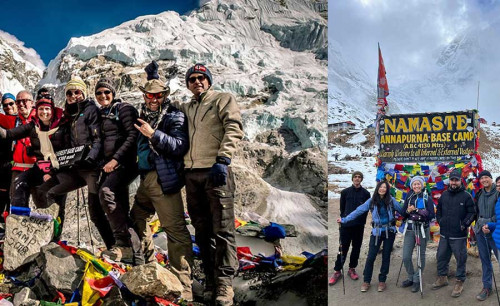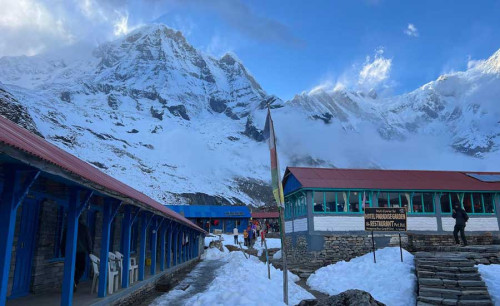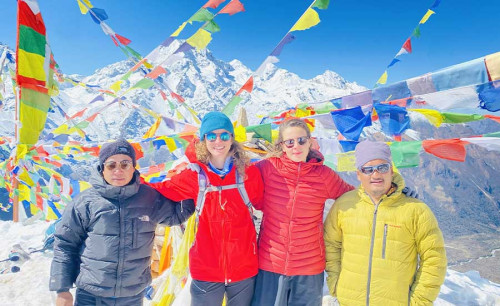Top 14 Highest Mountain In The World
Published On : 7th Sep, 2025 By Himalayan Dream Team
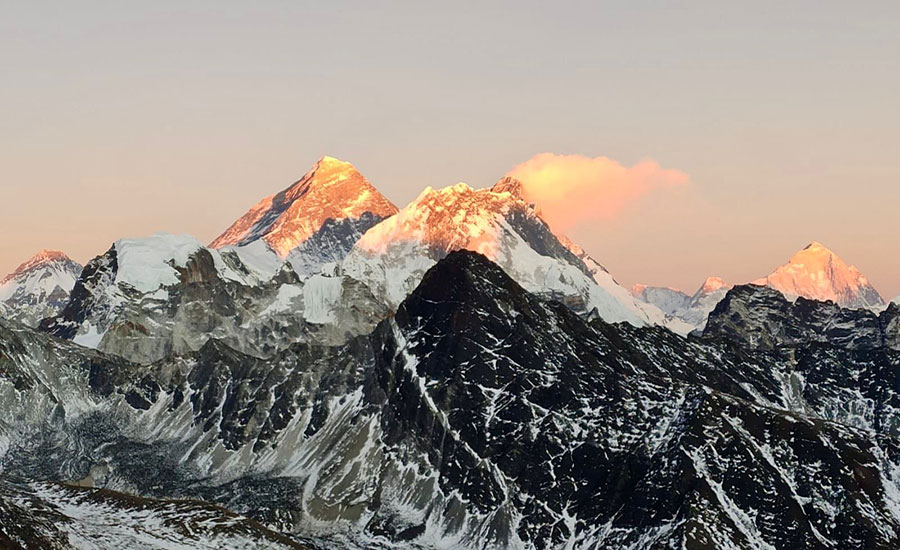
Mountains have always been a source of particular attraction for the adventurous, the mystical, and those who love nature. Their towering summits rise above the earth, often reflecting breathtaking examples of natural splendor, while at the same time posing formidable challenges to any who dare to scale them. In fact, all 14 of the highest mountains in the world stand within the Himalayan and Karakoram ranges, each higher than 8,000 meters. These are, in fact, more than the highest mountains in the world, legendary giants that have inspired innumerable stories and feats of human endurance. This blog unveils some interesting information about these summits and tales that have made them iconic in the world of mountaineering.
1. Mount Everest: The Ultimate Pinnacle
Height: 8,848 meters (29,029 feet)
Location: Border between Nepal and China (Tibet)
First Ascent: Tenzing Norgay (Nepal) and Sir Edmund Hillary (New Zealand) on May 29, 1953
Cultural Significance: Known as "Sagarmatha" in Nepal and "Chomolungma" in Tibet, Everest is a sacred site for the Sherpas.
At an elevation of 8,848 meters above sea level, Mount Everest is the highest point on Earth. For decades, its towering summit on the Nepal-China border has captured the imagination of climbers. The iconic first ascent by Tenzing Norgay and Sir Edmund Hillary in 1953 was a historic achievement in mountaineering. The extreme conditions of Everest also include temperatures as low as -60°C, with winds blowing fiercely, while the very dangerous regions are located in the Khumbu Icefall and the Hillary Step. Still, despite these challenges, Everest is a beacon of adventure-a living symbol of human endurance and the spirit of exploration. One can be aided in viewing the best scenery of the highest peak in the world, Mount Everest, through Everest Base Camp Trek provided by Himalayan Dream Team Treks & Tours.
2. K2 (Mount Godwin-Austen): The Savage Mountain
Height: 8,611 meters (28,251 feet)
Location: Border of Pakistan and China
First Ascent: Lino Lacedelli and Achille Compagnoni (Italy) on July 31, 1954
Cultural Significance: Known as the “Savage Mountain” due to its extreme difficulty.
K2 is known as the "Savage Mountain" for a reason; it is the second-highest mountain and has no easy way to the top. Even the most experienced climbers will find it a formidable task. The peak's weather is brutally harsh, with steep, icy slopes that attain an altitude considered one of the deadliest mountains. It fatality rate underlines the formidable risks involved in the ascent of it. To many climbers, however, the conquest of K2 is the ultimate test of skill and will; hazardous routes are a testimonial to bravery.
3. Kangchenjunga: The Five Treasures of Snow
Height: 8,586 meters (28,169 feet)
Location: Border of Nepal and India
First Ascent: Joe Brown and George Band (UK) on May 25, 1955
Cultural Significance: A sacred mountain to the people of Sikkim and Darjeeling.
Third-highest peak in the world, Kangchenjunga has a lot of rich cultural significance attached to itself. Locals revere it as the "Five Treasures of Snow." As the name goes, there are five peaks in this particular mountain chain, with each peak symbolizing wealth. Traditionally, many mountaineers would climb a few meters short of the actual summit in respect to its spiritual value. In conditions of rugged beauty and harsh conditions, that is, unpredictable weather and avalanche risks, mountaineers find it a very catchy yet challenging spot to test their limits. One of the finest views of one of the highest peaks in the world can be seen by doing the Kanchenjunga Circuit Trek by Himalayan Dream Team Treks & Tours.

4. Lhotse: The South Peak
Height: 8,516 meters (27,940 feet)
Location: Border of Nepal and China (Tibet)
First Ascent: Fritz Luchsinger and Ernst Reiss (Switzerland) on May 18, 1956
Cultural Significance: Known for its proximity to Everest, offering climbers a formidable challenge.
Lhotse immediately abuts Everest and, despite everything, lives in the shadow of its more famous counterpart; it is a serious climb on its own nonetheless. Its southern face drops in walls near to a mile and a half high, some of the hardest rock and ice in the Himalayas. Climbers share much of their ascent with the Everest route and face all of the same weather challenges. The reward is the breathtaking view from its summit, testament to how alluring the mountain can be for those who dare face its challenges.
5. Makalu: The Great Black
Height: 8,485 meters (27,838 feet)
Location: Border of Nepal and China (Tibet)
First Ascent: Lionel Terray and Jean Couzy (France) on May 15, 1955
Cultural Significance: Known for its technical difficulty and remote location.
Makalu's pyramidal peak offers probably the most unique challenge and is often considered the most intimidating. In Sanskrit, its name means "Great Black," referring to exposed, dark granite walls. Because of extreme weather and a rather remote setting, the mountain presents an opportunity for a very lonely climb to its summit. These challenges notwithstanding, Makalu is pristine beauty in its ruggedness, which solitude-seeking mountaineers would find appealing for their adventure-a raw, rewarding experience.

6. Cho Oyu: The Turquoise Goddess
Height: 8,188 meters (26,864 feet)
Location: Border of Nepal and China (Tibet)
First Ascent: Herbert Tichy, Joseph Jöchler, and Pasang Dawa Lama (Austria) on October 19, 1954
Cultural Significance: Known for its relatively easier ascent, making it a popular choice for climbers.
Cho Oyu, or "Turquoise Goddess," is considered less challenging compared to other peaks over 8,000 meters. The gentle slopes of this mountain and the generally stable weather make Cho Oyu a popular option for most climbers who intend to reach high altitudes. It's located close to the famous Gokyo Valley, yet another reason it's in demand, since most climbers can witness the enchanting scenery of the Himalayas without facing all the acute risks from other peaks.

7. Dhaulagiri: The White Mountain
Height: 8,167 meters (26,795 feet)
Location: Nepal
First Ascent: Kurt Diemberger, Peter Diener, Ernst Forrer, Albin Schelbert, Nawang Dorje, and Nyima Dorje (Switzerland/Austria/Nepal) on May 13, 1960
Cultural Significance: Known as “White Mountain” for its stunning snow-covered peaks.
Dhaulagiri is the seventh highest mountain in the world and stands within the borders of Nepal. In Sanskrit, the name Dhaulagiri means "White Mountain," which aptly describes this wonder clad in snow and ice. The climb to the top includes extremely steep slopes and complex rock and ice sections, which requires immense skill and stamina from any climber. It is remote and also has unpredictable weather, adding to its mystique and drawing adventurous souls to its icy heights.

8. Manaslu: The Mountain of the Spirit
Height: 8,163 meters (26,781 feet)
Location: Nepal
First Ascent: Toshio Imanishi (Japan) and Gyalzen Norbu (Nepal) on May 9, 1956
Cultural Significance: Revered as the “Mountain of the Spirit” in the local language.
Manaslu is the eighth highest peak, having great spiritual significance. It actually stands for "Mountain of the Spirit," requiring respect for its rich heritage from the people dwelling nearby. Climbing Manaslu in order to reach its summit is an act of human endurance aimed at making difficult ascents, heavy snowfalls, and avalanche risks part of their endeavors. Manaslu is a superb panorama with its remote setting, making it one of the favorite destinations among climbers who are in search of both adventure and an internal feeling with nature. From Himalayan Dream Team Treks & Tours, you get to see the best view of one of the highest peaks in the world-Manaslu-on Manaslu Trek.

9. Nanga Parbat: The Killer Mountain
Height: 8,126 meters (26,660 feet)
Location: Pakistan
First Ascent: Hermann Buhl (Austria) on July 3, 1953
Cultural Significance: Known as the “Killer Mountain” due to its deadly history.
Nanga Parbat boasts the ominous nickname of "Killer Mountain," with a notorious reputation in the high fatality rate. Against its dangers are dramatic beauty and formidable challenge, making it irresistible to climbers. In this ascent, every risk from the severe weather to avalanche threats can be entailed. In this regard, Hermann Buhl's solo ascent, through the Northern Route, in 1953, remains legendary in mountaineering history, thereby underlining dangers and appeal of such a daunting peak.
10. Annapurna I: The Goddess of Harvests
Height: 8,091 meters (26,545 feet)
Location: Nepal
First Ascent: Maurice Herzog and Louis Lachenal (France) on June 3, 1950
Cultural Significance: Sacred to local people, often called the “Goddess of the Harvests.”
Annapurna I-a stunningly beautiful mountain-stands as the "Goddess of Harvests." Yet, for its beauty, it encompasses within it one of the highest fatality rates among all 8,000-meter peaks. Climbers also have to bear quite unstable weather conditions, hazards related to avalanches, and other technical issues. The first successful ascent in 1950 by Maurice Herzog and Louis Lachenal marked a milestone in mountaineering history, and even today, the peak challenges the limits of those few who dare to scale it. If you want to see one of the closest and probably the best views of one of the highest peaks in the world, Annapurna I, then you could do the Annapurna Base Camp Trek with Himalayan Dream Team Treks & Tours.
11. Gasherbrum I: The Hidden Peak
Height: 8,080 meters (26,509 feet)
Location: Border of Pakistan and China
First Ascent: Pete Schoening and Andy Kauffman (USA) on July 5, 1958
Cultural Significance: Known as “Hidden Peak” for its remote location.
Gasherbrum I, commonly referred to as Hidden Peak, soars in thecdc rupture of rugged Karakoram. Being in a far-out area, it is more challenging for climbers because of its severe weather and technicalities involved. Such naming of the peak signifies its secludedness, and thereby it carries greater appeal toward those who seek a true wilderness experience. The successful climb by Pete Schoening and Andy Kauffman in 1958 was a milestone in high-altitude climbing history.
12. Broad Peak: The Extensive Summit
Height: 8,051 meters (26,414 feet)
Location: Border of Pakistan and China
First Ascent: Fritz Wintersteller, Marcus Schmuck, Kurt Diemberger, and Hermann Buhl (Austria) on June 9, 1957
Cultural Significance: Named for its extensive summit ridge.
Broad Peak has been aptly named, since it has a long, broad summit ridge. To climbers, it offers an interesting variety of highly steep and icy slopes combined with unpredictable weather that demands technical skill and much resilience. The first ascent by a team of Austrian climbers in 1957 was thus a huge feat when it occurred in the world of mountaineering. Not as famous as some of its towering neighbors, Broad Peak is an exhilarating adventure for those who dare to take on its heights.
13. Gasherbrum II: The Accessible Giant
Height: 8,035 meters (26,362 feet)
Location: Border of Pakistan and China
First Ascent: Fritz Moravec, Josef Larch, and Hans Willenpart (Austria) on July 7, 1956
Cultural Significance: Known for being one of the more accessible 8,000-meter peaks.
Gasherbrum II is considered by some to be one of the easier peaks of the 8,000-meter club, although it is by no means easy. Relatively easier access and fewer technical difficulties compared with other peaks in the same league make it a popular summit among high-altitude climbers. Because it is relatively more accessible, it is still harsh in terms of weather and wind; hence, careful preparation must be undertaken with respect to the formidable conditions of the mountain.
14. Shishapangma: The Hidden Treasure
Height: 8,027 meters (26,335 feet)
Location: China (Tibet)
First Ascent: Xu Jing (China) on May 2, 1964
Cultural Significance: Known as “Gosainthan” in Nepal; the only 8,000-meter peak entirely within Tibet.
Shishapangma is curiously the only mountain above 8,000 meters that lies entirely within Tibet. The first ascent in 1964 by Xu Jing is considered one of the significant records in China's mountaineering history. This mountain is more familiar in Nepal as "Gosainthan". Shishapangma offers challenging yet rewarding climbing. Its far-flung position and towering altitude call for competence and determination; embodying the spirit of exploration and adventure pursuit to conquer some of the toughest mountains in the world.
These towering peaks represent not only geographical but also cultural icons and natural wonders-continuing to inspire awe and challenge human limits. Each mountain tells its own story of triumph and tragedy, and taken together they become an indelible part of our planet's heritage, acting as a reminder of nature's beauty and power. Both to the confirmed climber and the armchair adventurer, the world's highest mountains invite the mind to explore its mysteries and marvel at its majesty.
Highest Peaks In The World Elevation, Location
Here you have the list of the highest peaks in the world with elevation and location of the peaks.
| Rank | Peak | Height (m) | Height (ft) | Location |
|---|---|---|---|---|
| 1 | Mount Everest | 8,848 | 29,029 | Border of Nepal and China (Tibet) |
| 2 | K2 (Mount Godwin-Austen) | 8,611 | 28,251 | Border of Pakistan and China |
| 3 | Kangchenjunga | 8,586 | 28,169 | Border of Nepal and India |
| 4 | Lhotse | 8,516 | 27,940 | Border of Nepal and China (Tibet) |
| 5 | Makalu | 8,485 | 27,838 | Border of Nepal and China (Tibet) |
| 6 | Cho Oyu | 8,188 | 26,864 | Border of Nepal and China (Tibet) |
| 7 | Dhaulagiri | 8,167 | 26,795 | Nepal |
| 8 | Manaslu | 8,163 | 26,781 | Nepal |
| 9 | Nanga Parbat | 8,126 | 26,660 | Pakistan |
| 10 | Annapurna I | 8,091 | 26,545 | Nepal |
| 11 | Gasherbrum I | 8,080 | 26,509 | Border of Pakistan and China |
| 12 | Broad Peak | 8,051 | 26,414 | Border of Pakistan and China |
| 13 | Gasherbrum II | 8,035 | 26,362 | Border of Pakistan and China |
| 14 | Shishapangma | 8,027 | 26,335 | China (Tibet) |
Mount Everest Climbing Expedition Cost 2024
Cost of Mount Everest Expedition 2024 varies depending on the several factors. Here you have the cost breakdown of the Mount Everest Expedition Cost 2024.
| Cost Category | Details | Estimated Cost (USD) |
|---|---|---|
| Permits & Visas | Nepal Tourist Visa (90-day multiple entry) | $125 |
| Climbing Permit for Everest | $11,000 | |
| Visa arrangement by local company (per group) | $2,500 | |
| Refundable waste deposit (per group) | $4,000 | |
| Local liaison officer (per group) | $3,000 | |
| Total Permits & Visas | $20,625 | |
| Insurance | Basic insurance coverage | $125 |
| Comprehensive insurance coverage | $500 | |
| Support | Sherpa supported trip | $45,000 |
| Sherpa guided trek | $50,000 | |
| Fully guided trek | $55,000 | |
| Tips | Porters, drivers, Sherpa, and guides (per day per person) | $500 |
| Accommodation | Teahouse and basic camps | $2,000 |
| Food | Meals at teahouses and on trek | $1,500 |
| Transportation | International flight to Kathmandu | $1,200 |
| Domestic flight to Lukla | $350 | |
| Helicopter transfer (optional) | $2,000 | |
| Oxygen | Oxygen bottles (5 bottles) | $2,500 |
| Mask and regulator | $500 | |
| Sherpa oxygen allowance | $2,000 | |
| Total Estimated Cost | $50,000 - $60,000 | |
Mount Everest Climbing Expedition Cost 2025
Cost of Mount Everest Expedition 2025 varies depending on the several factors. Here you have the cost breakdown of the Mount Everest Expedition Cost 2025.
| Cost Category | Details | Estimated Cost (USD) |
|---|---|---|
| Permits & Visas | Nepal Tourist Visa (90-day multiple entry) | $125 |
| Climbing Permit for Everest | $11,000 | |
| Visa arrangement by local company (per group) | $2,500 | |
| Refundable waste deposit (per group) | $4,000 | |
| Local liaison officer (per group) | $3,000 | |
| Total Permits & Visas | $20,625 | |
| Insurance | Basic insurance coverage | $125 |
| Comprehensive insurance coverage | $500 | |
| Support | Sherpa supported trip | $45,000 |
| Sherpa guided trek | $50,000 | |
| Fully guided trek | $55,000 | |
| Tips | Porters, drivers, Sherpa, and guides (per day per person) | $500 |
| Accommodation | Teahouse and basic camps | $2,000 |
| Food | Meals at teahouses and on trek | $1,500 |
| Transportation | International flight to Kathmandu | $1,200 |
| Domestic flight to Lukla | $350 | |
| Helicopter transfer (optional) | $2,000 | |
| Oxygen | Oxygen bottles (5 bottles) | $2,500 |
| Mask and regulator | $500 | |
| Sherpa oxygen allowance | $2,000 | |
| Total Estimated Cost | $50,000 - $60,000 | |
Mount Everest Climbing Expedition Cost 2026
Cost of Mount Everest Expedition 2026 varies depending on the several factors. Here you have the cost breakdown of the Mount Everest Expedition Cost 2026.
| Cost Category | Details | Estimated Cost (USD) |
|---|---|---|
| Permits & Visas | Nepal Tourist Visa (90-day multiple entry) | $125 |
| Climbing Permit for Everest | $11,000 | |
| Visa arrangement by local company (per group) | $2,500 | |
| Refundable waste deposit (per group) | $4,000 | |
| Local liaison officer (per group) | $3,000 | |
| Total Permits & Visas | $20,625 | |
| Insurance | Basic insurance coverage | $125 |
| Comprehensive insurance coverage | $500 | |
| Support | Sherpa supported trip | $45,000 |
| Sherpa guided trek | $50,000 | |
| Fully guided trek | $55,000 | |
| Tips | Porters, drivers, Sherpa, and guides (per day per person) | $500 |
| Accommodation | Teahouse and basic camps | $2,000 |
| Food | Meals at teahouses and on trek | $1,500 |
| Transportation | International flight to Kathmandu | $1,200 |
| Domestic flight to Lukla | $350 | |
| Helicopter transfer (optional) | $2,000 | |
| Oxygen | Oxygen bottles (5 bottles) | $2,500 |
| Mask and regulator | $500 | |
| Sherpa oxygen allowance | $2,000 | |
| Total Estimated Cost | $50,000 - $60,000 | |
Everest Expedition Gear List
Gear list required for doing Everest Expedition is listed below on the table:
| Gear | Description | Cost (Buy) | Cost (Rent) |
|---|---|---|---|
| Ice Axe | General mountaineering ice axe, sizes vary based on height. | $150 | $30 |
| Crampons | Modern steel 12-point crampons with anti-balling plates. | $200 | $40 |
| Climbing Harness | Includes belay loop, gear loops, adjustable leg loops and waist belt. | $100 | $20 |
| Trekking Poles | Collapsible trekking poles with snow baskets. | $60 | $15 |
| Ascender | One right or left-handed ascender, based on dominant hand. | $80 | $25 |
| High-Altitude Boots | All-in-one boot system, warm enough without overboots. | $800 | $150 |
| Down Parka | Heavily insulated with high-quality down fill, hood required. | $500 | $100 |
| Sleeping Bag | Rated to -40°F, down-filled for use above basecamp. | $600 | $120 |
14 Highest Mountain of the World - Facts and Record 2024
Discover the 14 Highest Mountains in the World: Fascinating Facts and Records
For every adventure enthusiast, the allure of the mighty eight-thousanders—those towering peaks that soar above 8,000 meters—is undeniable. Among these 14 majestic mountains, Nepal proudly hosts 8, including the world’s highest peak, Mt. Everest. These giants not only challenge the limits of human endurance but also carry with them a rich history of remarkable achievements and astonishing records.
At Trekking Trail Nepal, we've curated a collection of fascinating facts and records about these 14 highest mountains in the world. From the first daring ascents to modern-day feats that continue to push the boundaries of what's possible, our compilation offers insights that will captivate and inspire. Whether you're planning your next trekking adventure in Nepal or simply intrigued by the stories behind these monumental peaks, our detailed account of the 14 highest mountain facts and records is here for you. Explore the legends, the records, and the history that make these mountains the ultimate destination for climbers and trekkers alike.
30 Facts and Record of 14 Highest Mountain of the World
There are several facts and record of 14 highest Mountain of the world. Some of the major 30 facts and record of 14 highes mountain of the world are given below:
| Tier | No. | Fact/Record |
|---|---|---|
| Apex | 1 | Mount Everest - The Tallest Mountain on Earth, formed over 60 million years ago, rising by 0.25 inches annually. |
| Second Tier | 2 | Naming of Everest - Named in 1865 after British geographer Colonel Sir George Everest. Known as Sagarmatha in Nepalese and Chomolungma in Tibetan. |
| 3 | Cultural Significance - Everest is considered a deity in Sherpa and Tibetan cultures. | |
| 4 | Peak XV - Everest was originally called Peak XV in 1955 with a height of 29,003 feet. | |
| 5 | Current Official Height - Since 1956, Everest’s official height is recorded as 29,029 feet (8,848 meters). | |
| 6 | Geological Composition - Most of the 14 tallest mountains are composed of calcium carbonate, limestone, and marble. | |
| Third Tier | 7 | Dhaulagiri - The highest mountain located entirely within a single country, Nepal. |
| 8 | Country Distribution - Nepal hosts 8 out of 14 Eight-Thousander peaks, while China has 9. | |
| 9 | K2 Winter Attempts - K2 remains unconquered in winter despite multiple attempts, including the largest expedition in December 2019. | |
| 10 | First Summits - Annapurna was the first 8,000-meter peak to be summited, followed by Everest. | |
| 11 | Nirmal Purja's Record - Nirmal Purja, a former Gorkha soldier, climbed all 14 Eight-Thousanders in 187 days, including Everest, Lhotse, and Makalu in 48 hours. | |
| 12 | Single-Country Mountains - Only 5 of the 14 peaks are within one country’s borders. | |
| Fourth Tier | 13 | Border Peaks - 9 of the tallest peaks straddle two countries; 4 on the Nepal-China border, 1 on the Nepal-India border, and 4 on the China-Pakistan border. |
| 14 | Nepalese First Summiters - Only 4 of the first summiters of the 14 highest mountains are from Nepal: Everest, Cho Oyu, Manaslu, and Dhaulagiri. | |
| 15 | Historical Misconception - Dhaulagiri was considered the highest peak in the world from 1808 to 1847. | |
| 16 | Reinhold Messner - The first to summit all 14 Eight-Thousanders without supplemental oxygen, famously said, “I didn’t go up there to die, I went up there to live.” | |
| 17 | Kami Rita Sherpa - Holds the record for the most Everest summits with 24, aiming for more. | |
| Fifth Tier | 18 | Everest Traffic - Everest is the busiest mountain, with 5,780 different people summiting over 10,155 times between 1953 and 2019. |
| 19 | Multiple Summits - Only 244 climbers have summited more than twice, totaling 1,215 summits. | |
| 20 | Babu Chiri Sherpa - Spent 21 hours on the summit of Everest. | |
| 21 | Lakpa Gelu Sherpa - Reached the summit in a record 10 hours, 45 minutes, and 46 seconds. | |
| 22 | Climbing Routes - Everest has 17 different climbing routes, with the South Col Route being the most popular. | |
| 23 | Weight Loss - Climbers typically lose 4-11 kg during expeditions to the 14 highest peaks. | |
| Sixth Tier (Base) | 24 | Oxygen Levels - The summit of Everest has 65% less oxygen compared to sea level. |
| 25 | Age Restrictions - Climbers must be at least 16 years old on the Nepalese side and between 18-60 years on the Chinese side. | |
| 26 | Fixed Ropes - Over 10,000 meters of rope are fixed each climbing season on the South Col Route. | |
| 27 | K2 Naming - K2 was named by Mr. Thomas George in 1856. The "K" stands for Karakoram, the mountain range it belongs to. | |
| 28 | K2's Savage Reputation - Known as the "Savage Mountain" due to its deadly climbing conditions, as stated by George Bell. | |
| 29 | Annapurna's Deadliness - Annapurna is the deadliest of the 14, with a 25% fatality rate. | |
| 30 | Annapurna's Record - The first of the Eight-Thousanders to be summited, despite its high risk. |
Best options for trekking to see the highest mountain in the world Mount Everest
Everest Base Camp Trek

The Everest Base Camp Trek is one of the most iconic treks in the world, passing through traditional Sherpa villages and old monasteries en route to the Khumbu Glacier. This is a fascinating trek that offers great views of Mt. Everest, together with other towering peaks, ample opportunity to experience the culture and hospitality of the Sherpa people.
Everest Base Camp Trek with Helicopter Return

Everest Base Camp Trek with Helicopter Return: Combining the seriousness of trekking to Everest Base Camp with the luxury of flying back in style, this option allows you to enjoy the trek without retracing your steps while returning with panoramic aerial views of the Everest region.
Everest Three Passes Trek

Everest Three Passes Trek is meant for the more adventurous traveler who loves taking up challenges. This is a thrilling trek across three high-altitude passes: Kongma La, Cho La, and Renjo La, along with splendid 360-degree views of Mount Everest and other peaks. Along with visiting Everest Base Camp, this trek will cover a visit to the beautiful Gokyo Lakes.
Luxury Everest Base Camp Trek
There's Luxury Everest Base Camp Trek for the comfort-seeking trekkers. This Everest trekking offers a chance to experience pure luxury along the trails, with comfortable luxury lodges en route, and with a more leisurely pace, which allows comfort viewing of the beauty the Everest region has to offer while still making it to Everest Base Camp.
Pikey Peak Trek
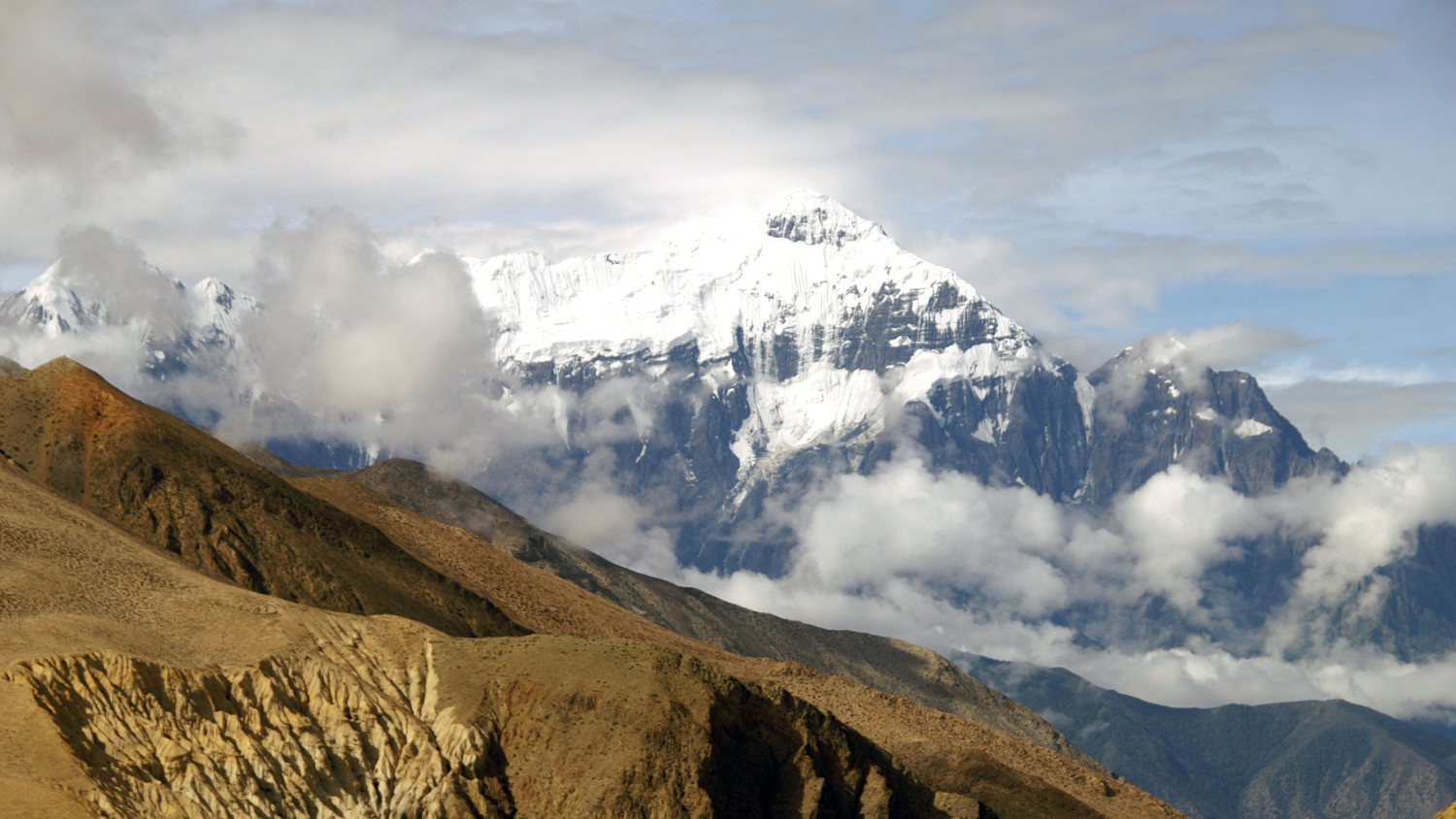
Pikey Peak Trek will be perfect for those who are looking for a shorter trek but off the beaten way and with good all-round panorama views. From the summit of Pikey Peak, some of the best views of Mount Everest and the surrounding peaks are displayed. It's less crowded compared to other treks but just as rewarding.
Everest Base Camp via Gokyo Lakes and Cho La Pass
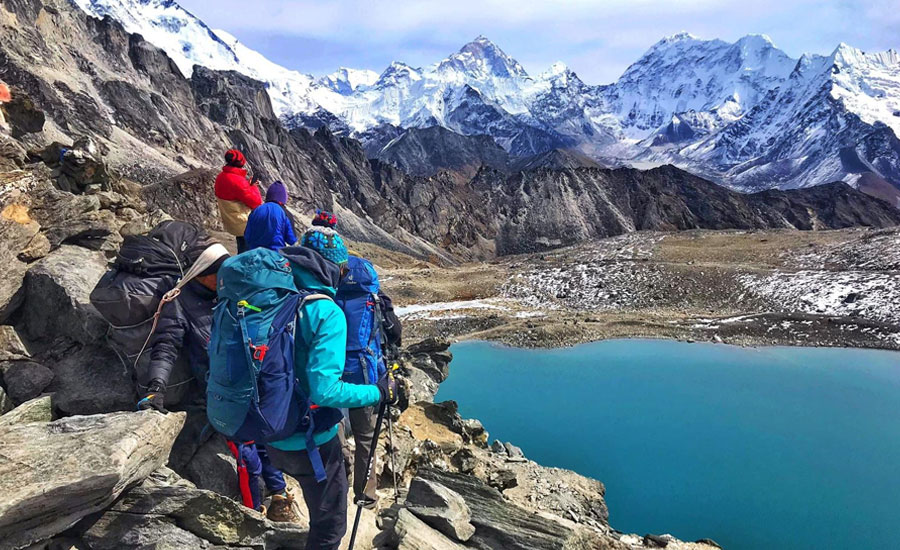
The breathtaking combination of Everest Base Camp, Sparkling Gokyo Lakes, and thrilling Cho La Pass is offered by Everest Base Camp via Gokyo Lakes and Cho La Pass. Extraordinary views of Everest from Gokyo Ri and a thrilling experience over the high altitude pass are provided to the trekkers along this route.
Arun Valley to Everest Base Camp

Arun Valley to Everest Base Camp is such a route that would suit those seeking a more secluded path. The route starts from Arun Valley, meandering through most varied landscapes, and then links up with the traditional Everest Base Camp route. Some of the highlights of this trek include the spectacular views and being encompassed by culture.
Trek to Everest View
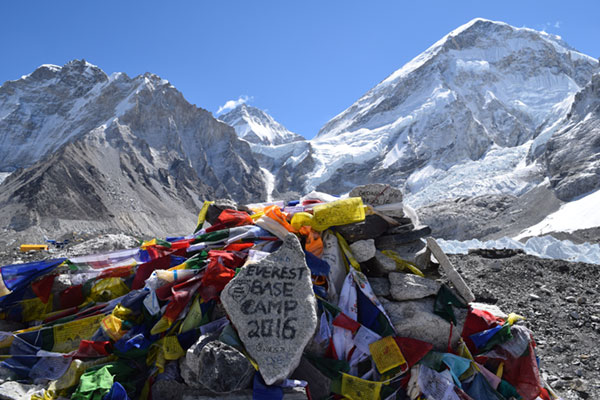
Everest View Trek is ideal for those who do not have time for base camp or are just beginners. This shorter trek enjoys great views of Mount Everest from places like Tengboche and Namche Bazaar, so it doesn't require much hassle going right to the base camp, hence less tiring.
Gokyo Lakes and Gokyo Ri Trek
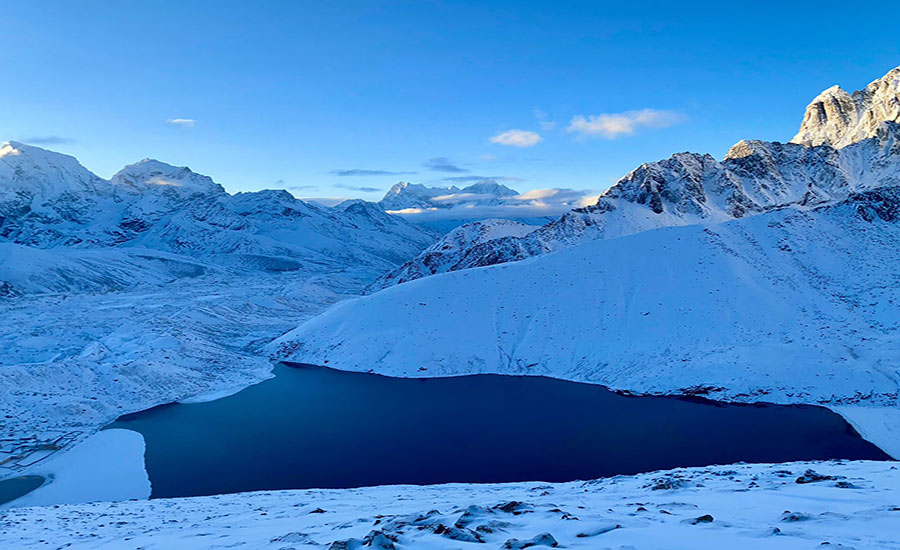
The Gokyo Lakes and Gokyo Ri Trek will be concentrated upon the crystal clear turquoise Gokyo Lakes, a chain of high-altitude glacial lakes, and the climb up to Gokyo Ri for some exceptional views of Mount Everest along with other peaks. This trek is ideal for those who are in pursuit of a quiet alternative to the traditional Everest Base Camp route.
Famous Climbing Records of the 14 Highest Mountains
- First ascents and pioneering expeditions.
- Records of fastest ascents and multiple summits.
- Nirmal Purja’s world record of climbing all 14 peaks in 187 days.
- Sherpa achievements: Kami Rita Sherpa’s Everest records.
Cultural and Spiritual Significance of the Highest Peaks
- Everest (Sagarmatha/Chomolungma): Sacred in Sherpa and Tibetan culture.
- Kanchenjunga: Revered as the “Five Treasures of Snow.”
- Annapurna I: Worshipped as the Goddess of Harvest.
- Manaslu: Known as the “Mountain of the Spirit.”
Why Nepal Is the Best Destination to See the Highest Peaks
- Nepal hosts 8 out of the 14 highest mountains in the world.
- Popular treks such as Everest Base Camp, Annapurna Circuit, and Manaslu Circuit provide stunning views.
- Easy access from Kathmandu to popular trekking hubs like Lukla, Pokhara, and Dharapani.
Best Treks to Experience the World’s Highest Peaks
-
Everest Base Camp Trek –Everest Base Camp Trek is the classic route to the foot of Everest.
-
Everest Base Camp with Helicopter Return – Everest Base Camp with Helicopter Return adds adventure plus luxury.
-
Annapurna Base Camp Trek – Annapurna Base Camp Trek offers stunning views of Annapurna I.
-
Manaslu Circuit Trek – Manaslu Circuit Trek is authentic, wild, and less crowded.
-
Kanchenjunga Circuit Trek – Kanchenjunga Circuit Trek offers close encounters with the world’s third-highest peak.
-
Gokyo Lakes and Cho La Pass Trek –Gokyo Lakes and Cho La Pass Trek is alternative Everest trek with turquoise lakes.
Recent Posts
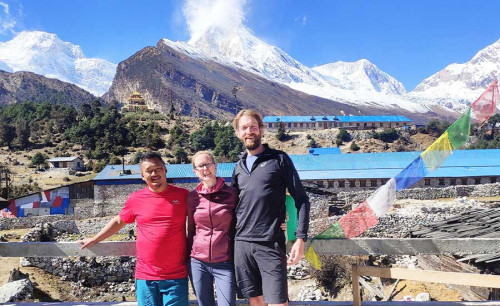
24th Nov, 2025
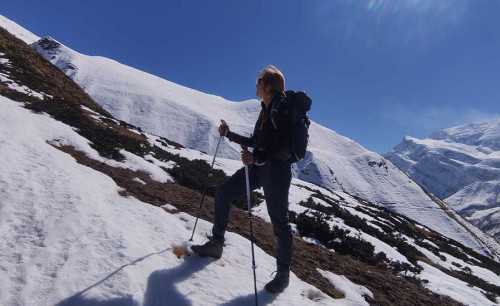
21st Nov, 2025
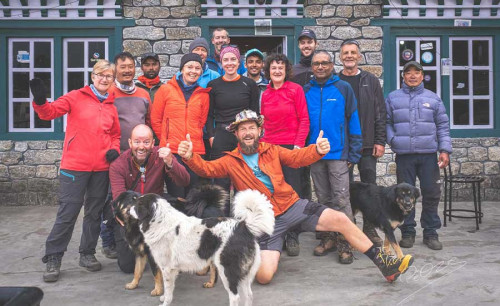
10th Nov, 2025
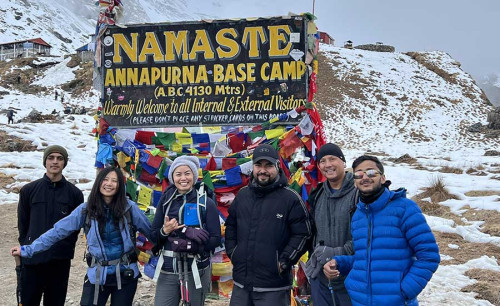
9th Nov, 2025

25th Oct, 2025

22nd Oct, 2025

17th Oct, 2025

17th Oct, 2025

13th Oct, 2025

12th Oct, 2025


